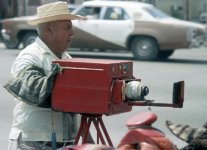I have to wonder... What parts of a pinhole would you need to rebuild?! 😉
I'm a paper negative/pinhole/glass lens shooter, and I've studied the attached article with interest. Contrary to the article, I believe the camera in question uses a glass lens stopped down to a tiny aperture, for wide DOF and exposure times much shorter than true pinhole. There also appears to be a focus mechanism in one of the article's images.
FYI, many so-called "pinhole" cameras from the 19th century were actually stopped-down glass lenses, not true pinhole. And many advertisements for so-called "pinhole video cameras" (for surveillance purposes, no doubt) are also obviously stopped-down glass lenses, not true pinhole.
The picture in the article showing a freshly processed paper negative seems to indicate a relatively fast shutter speed, and sharpness better than what a true pinhole alone can yield on a small negative; and also that the size of the camera being outstandingly larger than the size of the resulting negatives is because the camera also serves as the darkroom for processing and contact printing. The photographer reaches his arm inside, from the back, with a cloth keeping stray light out. I'm assuming there's a light trap labyrinth of sorts inside the box, permitting his arm to get to the dark portion of the camera without fogging the slow paper negative media. Containers inside this dark chamber permit processing the negative directly after exposure. I'm not even certain if fixer is used for the paper neg, just a water rinse after acid stop, as the immediate purpose for the paper negative is contact printing for the positive print.
I'm also assuming lots of chemical spills inside the camera over time necessitate it be repaired frequently.
I would be interesting to build something like this.
~Joe



